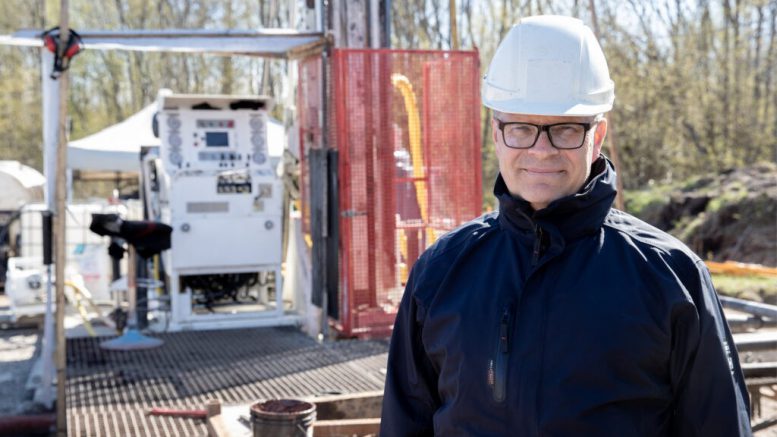North American mining contractors, equipment manufacturers and green energy investors have an opportunity to participate in a pumped hydro storage project in Estonia that will require the development of an underground mine solely to store 4.5 million cubic metres of water.
Energiasalv, the Estonian consortium leading the $1.3 to $1.5 billion (€750 to €800 million) Zero Terrain project, is scheduled to go to tender in September, and is casting a wide net to attract the necessary expertise and funding required for this and similar projects in the future, said Peep Siitam, Energiasalv’s CEO.
This first Zero Terrain project will be located at the seaside town of Paldiski, 50 km southwest of the capital Tallinn, and is a European Union Project of Common Interest supported by the European Climate, Infrastructure and Environment Executive Agency.
Pumped hydro storage is a mature technology that uses the gravitational potential energy of water exchanged between a higher and lower reservoir to store and generate energy. Until now, the technology has relied on mountainous terrain to account for the difference in elevation, greatly limiting its potential. For this project, the Estonian conglomerate will use the adjacent Gulf of Finland, part of the Baltic Sea, as the upper reservoir, and caverns at the base of a 740 metre mine as the lower reservoir.
The Paldiski Zero Terrain project will be the world’s first greenfield pumped hydro storage project using an underground mine for the lower reservoir.
The 740-metre main access shaft will have an inner diameter of 8.5 metres and be equipped with a hoist and a conveyance for transporting equipment and personnel. There will be a second shaft with an inner diameter of 5.5 metres to accommodate the flow of water between the two reservoirs, a 4.5-km incline tunnel, and 4.8-million cubic metres of excavation for the underground caverns.
When electricity prices drop during periods of low demand, water will be pumped from the lower reservoirs to Paldiski Bay. When demand spikes and prices are high, the flow is reversed, sending water through turbines to generate electricity and refill the underground caverns.
“Estonia currently relies heavily on polluting thermal power for energy production but is moving quickly toward wind and solar to comply with legislation mandating the reliance on 100% renewables by 2030,” said Siitam. “The Zero Terrain technology will help to balance the power system by supplementing the wind and solar energy when it is insufficient to meet the demand.”
Siitam describes the project as a 550MW underground “water battery” and claims its 6GWh storage capacity during one storage cycle of 12 hours will be sufficient to provide electricity at affordable prices for the average daily consumption of Estonia’s 550,000 households.
The power generated will serve Estonia and the greater Baltic market, including Latvia and Lithuania, as well as Finland.
Plans call for a total of 10 connected underground caverns measuring 30 metres in width and 50 metres in height. Six of them will be 400 metres in length with the remaining four measuring 300 metres long. Sublevel stoping and longhole drilling are proposed for the excavation of the caverns, but the mining method selected for the project will ultimately be determined by the contractor selected for the job.
The 4.5-km incline tunnel will be excavated by a tunnel boring machine and used for introducing heavy equipment including haul trucks, drill jumbos and scooptrams to the lower level of the mine. It will also include a conveyance system for the extraction of excavated rock.
Siitam, in fact, says the excavated granite will supply 15 million tonnes of crystalline aggregate for road construction that will replace imported high-cost igneous aggregate and low-quality limestone aggregate produced domestically, generating up to $297 million (€200 million) to help cover the cost of the project. The financing plan also includes $445 million €300 million) of equity and $667 million (€450 million) of bank loans and funding from export credit agencies.
The Energiasalv consortium includes Sunly AS, a pan-Baltic and Polish renewable energy producer, Alexela, an Estonian holding company with interests in energy, the metal industry and property development, and Tallinn-based Vool, Siitam’s own company. In July, Energiasalv attracted €11 million from three additional Estonian companies: Combiwood Grupp OÜ, a network of woodworking companies, Warmeston OÜ, a wood pellet producer, and Kiikri Kodu OÜ, a property developer.
Siitam would like to see up to 10 Zero Terrain projects around the globe by 2035 to provide the energy storage required for the shift to renewable power but has reservations about using abandoned mines. “A greenfield project,” he said, “gives us more freedom to design the storage capacity. Also, use of an abandoned mine still needs a lot of reconstruction to make it work, so I’m not optimistic that it can compete with a greenfield project.”
According to Siitam, pumped hydro storage is also three to five times less expensive than using Li-Ion batteries.
To access tender documents and for further information about the Zero Terrain project, go to www.energiasalv.ee/en/.
The preceding Joint-Venture Article is PROMOTED CONTENT sponsored by Energiasalv and produced in cooperation with The Northern Miner.


Be the first to comment on "JV Article: Zero Terrain pumped hydro project preps to launch"